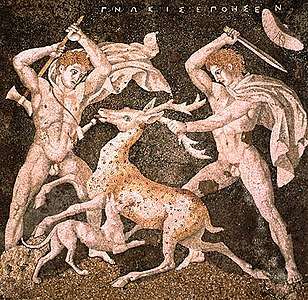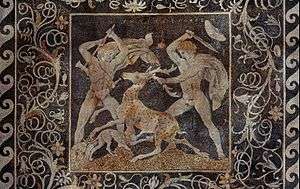Stag Hunt Mosaic


%2C_Ancient_Pella_(6913864630).jpg)
The Stag Hunt mosaic (c. 300 BCE) is a mosaic from a wealthy home of the late 4th century BC, the so-called "House of the Abduction of Helen" (or "House of the Rape of Helen"), in Pella, the capital of the Macedonian Kingdom. It bears the signature of the Ancient Greek artist Gnosis, of whom very little is known. It is now located in the Archaeological Museum of Pella, Central Macedonia, Greece.
Composition
The emblema is bordered by an intricate floral pattern, which itself is bordered by stylized depictions of waves.[2] The mosaic is a pebble mosaic with stones collected from beaches and riverbanks which were set into cement.[2] As was perhaps often the case,[3] the mosaic does much to reflect styles of painting.[4] The light figures against a darker background may allude to red figure painting.[4] The mosaic also uses shading, known to the Greeks as skiagraphia, in its depictions of the musculature and cloaks of the figures.[4] This along with its use of overlapping figures to create depth renders the image three dimensional.
It is often wondered if Gnosis, whose signature ("Gnosis epoesen", i.e. Gnosis created) is the first known signature of a mosaicist,[5] could have been the painter of an earlier picture which the mosaic reproduces, rather than the mosaic-setter. In the case of pottery, 'epoesen' referred to a maker of the pot while 'egraphsen' was the verb used to designate the painter.[6] Therefore, if an analogy to pottery is warranted, it seems likely for Gnosis to have been a mosaicist. Since gnosis (Greek: γνῶσις) is also the Greek word for knowledge, others have said the inscription does not refer to an author at all; but to an abstract noun.[7][8]
The Figures
The figure on the right is possibly Alexander the Great due to the date of this mosaic along with the depicted upsweep of the hair.[9] Pella is also the birthplace of Alexander. The figure to the left wields a double-headed axe, likely alluding to Hephaistos; meaning the figure depicted could be the general Hephaestion.[9] The dog depicted is possibly Peritas accompanying Alexander.[10] The stag is symbolic of Artemis in the myth where she transforms Actaeon into a Stag when he tries to rape her. Once he is turned into a stag his own turn on him and he is torn apart. Rape is a form of conquering, so it is not only symbolic of the Rape of Helen, in which this mosaic was found in the house she was abducted from, but also symbolic of conquering the Persians. The Persians attempting to conquer Greece is paralleled to them trying to impose their reign on Greece and Alexander taking revenge and conquering them instead. The dog in here reminds us of the original story where Actaeon's dogs tear him apart.
Deer in Greek Mythology
In Greek Mythology, The Stag is associated with Artemis who was the virginal huntress. The myth goes when Actaeon saw Artemis naked, out of anger she turned him into a stag and he was torn to pieces by his own. In other accounts it is thought that Actaeon tried to rape Artemis. In this image we see the same concept of a stag being torn apart by a dog just as in the myth as well as by Alexander the Great on the right. It is speculated who is on the left. The theme here is the "hunter being hunted". It is a quite fitting mosaic for The House of The Abduction Of Helen, who was raped.
The stag also represents the Persians that Alexander would later conquer. He had stated his motives for battling the Persians as to get vengeance for them sacking Athens and destroying temples there such as the Parthenon.[11] This would again represent the idea of the hunter being hunted.
References
| Wikimedia Commons has media related to Stag hunt mosaic (Pella). |
- ↑ Chugg, Andrew (2006). Alexander's Lovers. Raleigh, N.C.: Lulu. ISBN 978-1-4116-9960-1, pp 78-79.
- 1 2 Kleiner, Fred S., and Helen Gardner. Gardner's Art through the Ages. the Western Perspective. Boston, MA: Wadsworth Cengage Learning, 2010. pg. 135
- ↑ http://www.thejoyofshards.co.uk/history/index.shtml
- 1 2 3 Kleiner and Gardner, pg. 136
- ↑ Mosaics of the Greek and Roman world By Katherine M. D. Dunbabin pg. 14
- ↑ Mertens, Joan R. . How to Read Greek Vases. New York: Metropolitan Museum of Art and Yale UP, 2010. pg. 13
- ↑ Cohen, Ada. Art in the Era of Alexander the Great: Paradigms of Manhood and Their Cultural Traditions. New York: Cambridge UP, 2010. pg. 32
- ↑ Paolo Moreno thinks it was intended to be read as "Apelles's Knowledge Made It".
- 1 2 Chugg, Andrew. Alexander's Lovers. Raleigh, N.C.: Lulu, 2006. pg. 78
- ↑ Chugg, Andrew. Alexander's Lovers. Raleigh, N.C.: Lulu, 2006. pg. 79
- ↑ Ros, Karen. “The Late Classical Period of Ancient Greece.” Lecture, Ancient Greek Art and Archaeology UIC, Chicago, Nov 2017.